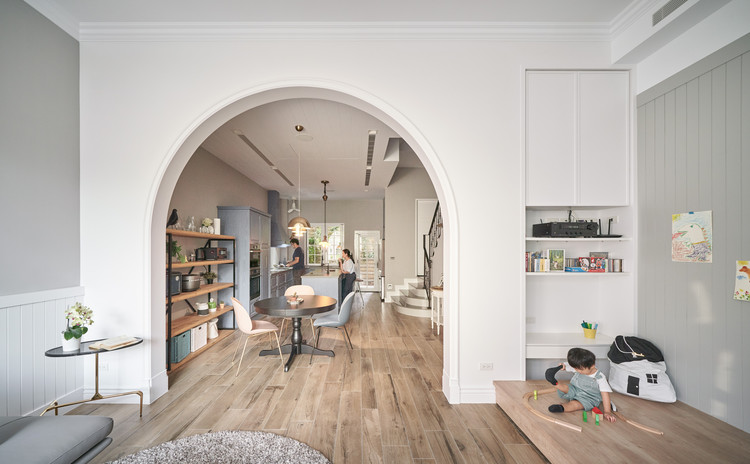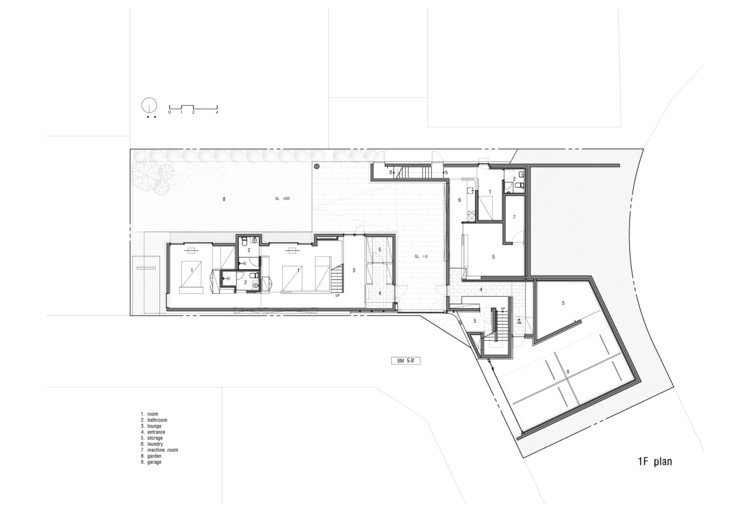Yotsuya Tenera Key Operation
2011-10-15 00:00
架构师提供的文本描述。该项目的现场是步行五分钟从Yotsuya站,位于一个安静的居民区,就在新宿街。这一地区有许多寺庙、神殿和相当密集的住房。就像一个不断扩展的空间网络,这些房屋和建筑群填补了街道和小巷之间的空白。这座住宅建筑群原计划建在一个有10米正面和17米深度的曲柄空间上。由于新宿病房工作室公寓的规定,规划出12套住房建筑群,包括9套面积不足30平方米的单元和3套30平方米以上的单元。
Text description provided by the architects. The project site is in a five-minute walk from Yotsuya Station located in a quiet residential area right behind the Shinjuku Street. This area holds many temples, shrines and also fairly dense housing. Like a spreading network of space, those houses and complexes fill the blank spaces between the streets and alleys. This housing complex was planned to be built on the site of a crank space with 10m of the frontage and 17m in depth. Due to the regulation for Shinjuku Ward studio apartments, 12 units of the housing complex was planned out including 9 units of less than 30m² of the floor area and 3 units of more than 30 m².
(3)Sobajima Toshihiro Sobajima
Volume Layout and Flow Lines to Maximize the Rental Area
从房地产线上看,该项目工地遭遇了200万次挫折。通常情况下,后退是倾向于向南提供,并设置了一个接近北部,以获得白天的光线。然而,位于工程场地南面的邻近土地有一条通往他们的旗杆状地块的通道。由于南方的这种状况,预计会有足够的日光流向项目工地。为了获得尽可能多的建筑面积,将建筑质量向南推进,将后退空间作为进场花园,并作为疏散通道,需要超过2米宽的疏散通道。由于整体布局,研究了循环空间,以使所有12个单元包含在L型体积。在该方案中,在建筑物内提供了2个空位,作为正常运行的楼梯。有了这个紧凑型楼梯箱,出租面积的楼面面积就增加了。采用一种有效的方法,比典型的单边走廊方案更有效地减少了公共空间的面积。
The project site has 2m of setback from the property line. Normally the set back is tending to be provided to the south, and an approach is set to the north in order to gain the day light. However, the neighboring land located on the south of the project site has a passage to their flag-pole-like plot. And because of this condition on the south, adequate amount of daylight was expected to flow towards the project site. In order to gain as much of the building area as possible, the building mass is pushed towards the south, and the setback space is utilized as an approach garden and it also works as the evacuation passage which needs to be more than 2m width. As a result of the overall layout, the circulation space was studied in order to make all the 12 units accessible contained in the L-shaped volume. In this scheme, 2 void spaces were provided within the building mass as functioning stairways. With this compact stair cases, the floor areas of the rental area is increased. By using an efficient approach, the area of the common space was reduced even more efficiently than the typical one-sided corridor scheme.
Continuous Tree-Shaped Void Space into the Gaps in Yotsuya
一般来说,这种内部楼梯往往是幽闭恐惧症空间。然而,空隙空间是与每个住宅单元的阳台相连的连续树形空隙空间,分布在阳台上,向相邻的住宅建筑、庭院、后面的通道和相邻的公寓走廊延伸。考虑到阳台区域的通风目的,将楼梯与阳台分开的竖向钢筋承担楼梯的垂直荷载,并以开放的结构减轻空间的负担。此外,天窗带来了自然的白天光线,并有助于促进烟囱效应,以通风的空间。
In general, this kind of internal staircase tends to be claustrophobic space. However, the void space is linked with each residential unit’s balconies as continuous Tree-Shaped Void Space and spread throughout the balconies, towards the gaps in neighboring residential buildings, the courtyard, the passage at the back, and the neighboring apartment corridors. Considering the ventilation purpose for the balcony areas, the vertical steel bars separating the staircase from the balconies carry the vertical load of the stairs and lighten up the spaces with the open structure. Also, the skylights bring the natural day light and help promote the chimney effect to ventilate the spaces.
Diversity of Dwelling Units
每一个住宅单元都是围绕着树形的空隙而形成的。根据外墙和空隙的形状,所有单元都有不同的地板布局:l型、I型、T型和C型。简单的20平方米单位是为一个人提供的,一两个人将占据其他形状的30平方米单位。例如,C形单元提供距离和切割远景,以便在该单元的两个使用者之间创建隐私。所有住宅单元都有阳台空间或露台。从楼梯走进住宅单元,穿过住宅单元,走出阳台,楼梯再次出现。每个单元的远端通过空隙与前面的入口区域相连。在单元布局中保持巨大的隐私感,这一空白是为了创造一种社区感,并鼓励居民之间的互动。
Every dwelling unit has been formed to surround the Tree-Shaped void space. Depending on the exterior walls and the shapes of the void, all units have different floor layouts: L-shape; I-shape; T-shape; and C-shape. The simple shape of 20 m² units is provided for a single person, and a couple or two people would occupy 30 m² units in the other shapes. For example the C-shape unit provides the distance and the cut the vista in order to create the privacy between the two occupants of the unit. All the dwelling units have either balcony spaces or terraces. Walking into a dwelling unit from the staircase, through the dwelling unit, and come out to the balcony, the staircase appears once again. The far end of each unit is linked with the entrance area at front through the void. Keeping the great sense of privacy in the unit layout, this void is meant to create a sense of community and encourages interactions among dwellers.
(3)Sobajima Toshihiro Sobajima
Texture on the Concrete Wall
混凝土结构是本工程的重要设计标准之一。与周边建筑相比,该建筑群的体积相对较大,但与周围建筑的规模和外观仍保持平衡;采用木质纹理软化了坚硬的浇筑混凝土饰面,创造了友好和谐的外观。一般情况下,柏木胶合板是用于模板。然而,在这一过程中,建筑成本需要削减。因此,选择落叶松胶合板作为模板。了解到落叶松木材会吸收大量水分并被弯曲,而且它的颗粒不会在混凝土表面很好地脱落的事实,胶合板的品种也在这个过程中进行了初步测试。以落叶松胶合板为材料,在基层模板制作过程中对不同的木材材料进行了试验,并在浇筑混凝土前在表面涂上了防潮材料。最后,混凝土表面上的颗粒很漂亮地露了出来。镀锌金属框架连接在开口上。金属框架赋予木材纹理混凝土突出的口音,并防止窗户从雨水中弄脏正面。此外,这个框架可以削减从一个单位到另一个单位在L型建筑的体积。
Concrete texture of this project is one of the important design criteria. In comparison with the surrounding buildings, the volume of this complex is relatively larger, but it still balances up with the scale of the surrounding buildings with its appearance; harsh cast concrete finish was softened with wood texture to create friendly and harmonious appearance. In general, cedar plywood is used for formwork. However, the construction cost needed to be cut in the process. Therefore, larch plywood was chosen for the formwork. Knowing the facts that larch wood would absorb a lot of moisture and be bent up and that its grain wouldn’t come out well on the concrete surface, varieties of plywood were also tested initially in the process. By experimenting different wood materials in the process of formwork at the base, larch plywood was coated with damp proof material, and remover was painted on the surface before casting concrete. At the end, the grain came out beautifully on the surface of the concrete. The galvanized metal frames were attached to the openings. The metal frames give an accent to the wood-textured concrete stand out and prevent the windows from rain water to smudge the facade. Moreover this frame can cut the view from one unit to another at the L-shape volume of this building.
(3)Sobajima Toshihiro Sobajima
阳台空间与通往周围社区的开放空间相连的楼梯相连,还与庭院有视觉联系,就好像它们代表着这一复杂地区的相邻街道一样。挫折空间不仅是为了应对规则而提供的缓冲空间,还可以作为一个吸引人的庭院空间,为每个住宅单元提供很好的景观。因此,整个建筑群已经融入了有许多绿色和许多小巷的Yotsuya。
The balcony space interlocked with the staircase connected to the open space towards the surrounding neighborhood and also visually linked with the court yard as if they were to represent the neighboring streets of this intricate area. Setback space is not provided only for a buffer space to cope with the regulation, but also functioning as an attractive courtyard space to provide great views to each dwelling unit. As a result, the whole complex has become blended into Yotsuya with lots of green and many alleys.
Text provided by Key Operation.
 举报
举报
别默默的看了,快登录帮我评论一下吧!:)
注册
登录
更多评论
相关文章
-

描边风设计中,最容易犯的8种问题分析
2018年走过了四分之一,LOGO设计趋势也清晰了LOGO设计
-

描边风设计中,最容易犯的8种问题分析
2018年走过了四分之一,LOGO设计趋势也清晰了LOGO设计
-

描边风设计中,最容易犯的8种问题分析
2018年走过了四分之一,LOGO设计趋势也清晰了LOGO设计






























































































